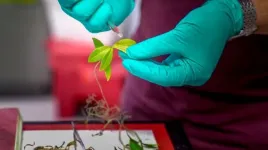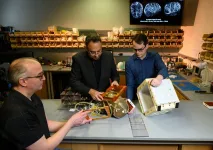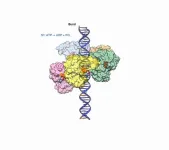INFORMATION:
About Cleveland Clinic
Cleveland Clinic - now in its centennial year - is a nonprofit multispecialty academic medical center that integrates clinical and hospital care with research and education. Located in Cleveland, Ohio, it was founded in 1921 by four renowned physicians with a vision of providing outstanding patient care based upon the principles of cooperation, compassion and innovation. Cleveland Clinic has pioneered many medical breakthroughs, including coronary artery bypass surgery and the first face transplant in the United States. U.S. News & World Report consistently names Cleveland Clinic as one of the nation's best hospitals in its annual "America's Best Hospitals" survey. Among Cleveland Clinic's 70,800 employees worldwide are more than 4,660 salaried physicians and researchers, and 18,500 registered nurses and advanced practice providers, representing 140 medical specialties and subspecialties. Cleveland Clinic is a 6,500-bed health system that includes a 173-acre main campus near downtown Cleveland, 19 hospitals, more than 220 outpatient facilities, and locations in southeast Florida; Las Vegas, Nevada; Toronto, Canada; Abu Dhabi, UAE; and London, England. In 2020, there were 8.7 million total outpatient visits, 273,000 hospital admissions and observations, and 217,000 surgical cases throughout Cleveland Clinic's health system. Patients came for treatment from every state and 185 countries. Visit us at clevelandclinic.org. Follow us at twitter.com/ClevelandClinic. News and resources available at newsroom.clevelandclinic.org.
Editor's Note: Cleveland Clinic News Service is available to provide broadcast-quality interviews and B-roll upon request.
Study shows obesity may increase risk of long-term complications of COVID-19
Among COVID-19 survivors, risk of hospital admission after the acute phase of the disease was 30% higher in patients with obesity
2021-06-03
(Press-News.org) Thursday, June 3, 2021, CLEVELAND: A Cleveland Clinic study shows that survivors of COVID-19 who have moderate or severe obesity may have a greater risk of experiencing long-term consequences of the disease, compared with patients who do not have obesity. The study was recently published online in the journal of Diabetes, Obesity and Metabolism.
Multiple studies have identified obesity as a risk factor for developing a severe form of COVID-19 that may require hospital admission, intensive care, and ventilator support in the early phase of the disease. Obesity, which is a complex disease caused by multiple factors, is associated with an increased risk for cardiovascular disease, blood clots and lung conditions. In addition, obesity weakens the immune system and creates a chronic inflammatory state. Those conditions can lead to poor outcomes after an infection with SARS-CoV-2, which is the virus that causes COVID-19.
"To our knowledge, this current study for the first time suggests that patients with moderate to severe obesity are at a greater risk of developing long-term complications of COVID-19 beyond the acute phase," said Ali Aminian, M.D., director of Cleveland Clinic's Bariatric & Metabolic Institute and principal investigator of the research.
In this observational study, researchers used a registry of patients who tested positive for SARS-CoV-2 infection within the Cleveland Clinic health system in a five-month period from March 2020 to July 2020, with follow-up until January 2021.
Researchers examined three indicators of possible long-term complications of COVID-19 - hospital admission, mortality, and need for diagnostic medical tests - that occurred 30 days or later following the first positive viral test for SARS-CoV-2. The outcomes were compared among five groups of patients based on their body mass index (BMI): 18.5-24.9 (normal), 25-29.9 (overweight), 30-34.9 (mild obesity), 35-39.9 (moderate obesity), and 40 or greater (severe obesity). Obesity is a disease classified as having a BMI of 30 or greater.
A total of 2,839 patients who did not require ICU admission and survived the acute phase of COVID-19 were included in the final results of this study. The normal BMI group was considered as a reference.
The study found that a health condition called post-acute sequelae of SARS-CoV-2 infection (PASC) is an extremely common problem in COVID-19 survivors. Specifically, during a 10-month follow-up after the acute phase of COVID-19, 44% of the study participants had required hospital admission and 1% died. Furthermore, results show that compared with patients with normal BMI, the risk of hospital admission was 28% and 30% higher in patients with moderate and severe obesity, respectively. The need for diagnostic tests to assess different medical problems, compared with patients with normal BMI, was 25% and 39% higher in patients with moderate and severe obesity, respectively.
More specifically, the need for diagnostic tests to assess cardiac, pulmonary, vascular, renal, gastrointestinal, and mental health problems was significantly higher in patients with a BMI of 35 or greater, compared with normal BMI patients.
"The observations of this study can possibly be explained by the underlying mechanisms at work in patients who have obesity, such as hyper-inflammation, immune dysfunction, and comorbidities," said Bartolome Burguera, M.D, Ph.D., chair of Cleveland Clinic's Endocrinology & Metabolism Institute and co-investigator of the study. "Those conditions can lead to poor outcomes in the acute phase of COVID-19 in patients with obesity and could possibly lead to an increased risk of long-term complications of COVID-19 in this patient population."
Future studies are planned to confirm findings of this study that obesity is a major risk factor for the development of PASC and determine the long-term and rigorous follow-up that patients with obesity need after a SARS-CoV-2 infection.
ELSE PRESS RELEASES FROM THIS DATE:
UNH research: Black bears may play important role in protecting gray fox
2021-06-03
DURHAM, N.H.-- Bears are known for being devoted and protective of their baby cubs, but research from the University of New Hampshire shows that they may also play a significant role in shielding gray fox from predators like coyotes, who compete with the fox for food and space. The research is one of the first studies to show how black bears provide a buffer to allow other, smaller carnivores to safely co-exist.
"Even though black bears and coyotes are the two most common carnivores in North America, we're still learning how they affect the ecosystems around them," said Rem Moll, assistant professor of wildlife ecology and lead author ...
The biodegradable battery
2021-06-03
The fabrication device for the battery revolution looks quite unconspicuous: It is a modified, commercially available 3D printer, located in a room in the Empa laboratory building. But the real innovation lies within the recipe for the gelatinous inks this printer can dispense onto a surface. The mixture in question consists of cellulose nanofibers and cellulose nanocrystallites, plus carbon in the form of carbon black, graphite and activated carbon. To liquefy all this, the researchers use glycerin, water and two different types of alcohol. Plus a pinch of table salt for ionic conductivity.
A sandwich of four layers
To build a functioning supercapacitor from these ingredients, four layers are needed, all flowing out of the 3D printer one after the ...
Enantiomorph distribution maps for metals and metallic alloys
2021-06-03
Left- or right-handedness is a symmetry property that many macroscopic objects also exhibit and which is of immense importance, particularly for the bioactivity of organic molecules. Chirality is also relevant for physical or chemical properties such as optical activity or enantioselectivity of crystalline solids or their surfaces. In the case of chiral metallic phases, unconventional superconductivity and unusual magnetic ordered states are linked to the chirality of the underly-ing crystal structure. Despite this connection between chirality and the properties of a material, detection is often difficult because left-handed and righthanded ...
Are wind farms slowing each other down?
2021-06-03
The expansion of wind energy in the German Bight and the Baltic Sea has accelerated enormously in recent years. The first systems went into operation in 2008. Today, wind turbines with an output of around 8,000 megawatts rotate in German waters, which corresponds to around eight nuclear power plants. But space is limited. For this reason, wind farms are sometimes built very close to one another. A team led by Dr. Naveed Akhtar from Helmholtz Zentrum Hereon has found that wind speeds at the downstream windfarm are significantly slowed down. As the researchers now write in the journal Nature Scientific Reports, this braking effect results in astonishingly large-scale low wind pattern noticeable in mean ...
Alzheimer's disease raises the risk of severe COVID-19 and death from this viral disease
2021-06-03
Neurodegenerative disorders that cause dementia increase the risk of contracting severe COVID-19 and dying from the disease. For people with Alzheimer's the risk is three times greater. It can be six times greater if they are over 80, according to a study conducted in Brazil by researchers at the University of São Paulo (USP) and Butantan Institute in partnership with colleagues at the Federal University of Rio de Janeiro (UFRJ).
An article on the study, which was supported by FAPESP, is published in Alzheimer's & Dementia: The Journal of the Alzheimer's Association.
"We found that all causes of dementia are risk factors for severity and death in COVID-19 and that these ...
Nanoscale sensors measure elusive water levels in leaves
2021-06-03
ITHACA, N.Y. - Water regulation in leaves is vital to a plant's health, affecting its growth and yield, disease susceptibility and drought resistance.
A breakthrough technology developed by Cornell University researchers uses nanoscale sensors and fiber optics to measure water status just inside a leaf's surface, where water in plants is most actively managed.
The engineering feat provides a minimally invasive research tool that will greatly advance the understanding of basic plant biology, and opens the door for breeding more drought-resistant crops. The technology could eventually be adapted for use as an agronomic tool for measuring water status in crops in real time.
The study in maize plants, "A Minimally Disruptive Method for Measuring Water Potential In-Planta ...
Using advanced imaging to study sickle cell disease
2021-06-03
Sickle Cell Disease (SCD) is a genetically inherited group of red blood cell disorders. END ...
Researchers reveal the inner workings of a viral DNA-packaging motor
2021-06-03
DURHAM, N.C. - A group of researchers have discovered the detailed inner workings of the molecular motor that packages genetic material into double-stranded DNA viruses. The advance provides insight into a critical step in the reproduction cycle of viruses such as pox- herpes- and adeno-viruses. It could also give inspiration to researchers creating microscopic machines based on naturally occurring biomotors.
The research was conducted by scientists from Duke University, the University of Minnesota, the University of Massachusetts and the University of Texas Medical Branch (UTMB). The results appear online in a trilogy of papers published in Science Advances, ...
Fifty years of progress in women's health
2021-06-03
WHO: JoAnn Manson, MD, DrPH, Physician and Epidemiologist, Division of Preventive Medicine, Brigham and Women's Hospital; co-author of a new Perspective piece published in The New England Journal of Medicine (pdf attached)
WHAT: Less than 50 years ago, a U.S. Supreme Court decision paved the way for women's use of contraception irrespective of marital status, and a year later, in 1973, the Court ruled in Roe v. Wade that women have a right to legalized abortion. In recent decades, clinical researchers and policymakers alike have made important strides ...
Let's talk about the elephant in the data
2021-06-03
You would not be surprised to see an elephant in the savanna or a plate in your kitchen. Based on your prior experiences and knowledge, you know that is where elephants and plates are often to be found. If you saw a mysterious object in your kitchen, how would you figure out what it was? You would rely on your expectations or prior knowledge. Should a computer approach the problem in the same way? The answer may surprise you. Cold Spring Harbor Laboratory Professor Partha Mitra described how he views problems like these in a "Perspective" in Nature Machine Intelligence. He hopes his insights will help researchers teach computers how to analyze complex systems more effectively.
Mitra thinks it helps to understand the nature of knowledge. Mathematically speaking, many data scientists ...
LAST 30 PRESS RELEASES:
Review article | Towards a Global Ground-Based Earth Observatory (GGBEO): Leveraging existing systems and networks
Penn and UMich create world’s smallest programmable, autonomous robots
Cleveland researchers launch first major study to address ‘hidden performance killer’ in athletes
To connect across politics, try saying what you oppose
Modulating key interaction prevents virus from entering cells
Project explores barriers to NHS career progression facing international medical graduates
Jeonbuk National University researchers explore the impact of different seasonings on the flavor perception of Doenjang soup
Two Keck Medicine of USC Hospitals named Leapfrog Top Teaching Hospitals
World-first discovery uncovers how glioblastoma tumours dodge chemotherapy, potentially opening the door to new treatments
A fatal mix-up: How certain gut bacteria drive multiple sclerosis
New AI tool identifies not just genetic mutations, but the diseases they may cause
Deep-learning model predicts how fruit flies form, cell by cell
Combination pills for high blood pressure may simplify treatment, improve long-term health
Immune system keeps mucosal fungi in check
Neurons within the brain use simple rules to localize genetic messages
Electrodes created using light
Second-hand gift-giving is a well-deliberated decision
How human interaction drove evolution to make bears less aggressive
National Poll: Few parents offer teens guidance on healthy eating during holiday season
Cannabis derivatives could provide new ovarian cancer treatments
Raising strong yeast as a petroleum substitute
Clues to the origin of hot Jupiters hidden in their orbits
Canada’s reduced pledge to Global Fund will impact domestic health
1 in 4 children with major traumatic injuries not cared for in pediatric trauma centres
Duke and Duke-NUS’ joint cross-population research to uncover "East-West" differences in disease and care
Scientists to ‘spy’ on cancer- immune cell interactions using quantum technology breakthrough
Tech savvy users have most digital concerns
Making lighter work of calculating fluid and heat flow
Normalizing blood sugar can halve heart attack risk
Lowering blood sugar cuts heart attack risk in people with prediabetes
[Press-News.org] Study shows obesity may increase risk of long-term complications of COVID-19Among COVID-19 survivors, risk of hospital admission after the acute phase of the disease was 30% higher in patients with obesity






